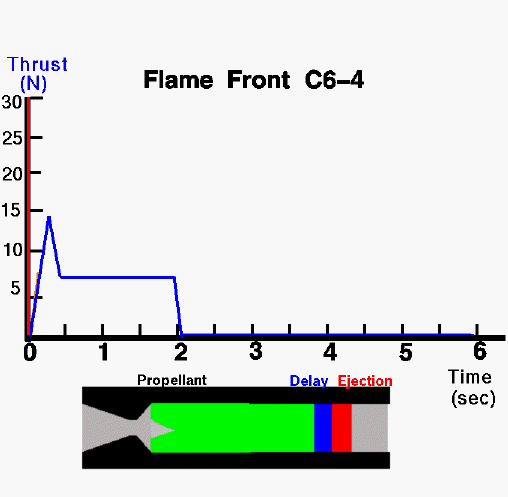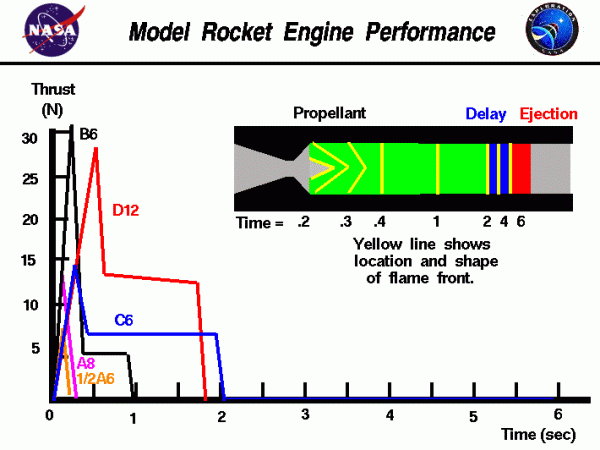Model Rocket Engine Performance Animated
Flying Model Rockets
Flying model rockets is a relatively safe and inexpensive way for students to learn the basics of forces and the response of vehicles to external forces. Like an airplane, a model rocket is subjected to the forces of weight, thrust, and aerodynamics during its flight. The weight and aerodynamics are determined by the design of the model rocket components. The thrust is provided by a replaceable solid rocket engine which can be purchased at hobby or toy stores.
Model Rocket Performance
Model rocket performance (how far, how high, how fast) depends a great deal on the rocket engine performance. There are several different ways to characterize rocket engine performance. Model rocket engines come in a variety of sizes and weights, with different amounts of propellant, with different burn patterns, which effects the thrust profile and with different values of the delay charge, which sets the amount of time for the coasting phase of the flight. On this page, we discuss the factors that affect model rocket engine performance.
Typical Performance Curves
At the top of the page, we show typical performance curves for several different rocket engines. We plot the thrust of the engine versus the time following ignition for each engine. You will notice that when comparing engines, there is a great difference between the levels and shapes of the plots. For any single engine, the thrust changes with time. To the right in the figure, we show a typical engine schematic which is used to explain why the thrust changes. The thrust of any rocket engine depends on how fast and how much hot exhaust gas passes through the nozzle.
Solid rocket propellant only burns at the surface of the propellant and the surface burns away as the propellant turns into a gas. You can then imagine a flaming surface that moves through the propellant. The flaming surface is called the flame front. At any time and at any location the amount of hot gas being produced depends on the area of the flame front. The greater the area, the greater the thrust. As the propellant burns, the shape and area of the flame front change and that causes the thrust to change.
Here is a computer animation of the movement of the flame front for a typical engine:

Describing the Animation
In the animation, we show the shape and location of the flame front for a C6-4 engine. Engine designations are explained on another page. The schematic is two dimensional while the real engine is three dimensional. So, a three-dimensional cone surface appears as a two-dimensional angle on the schematic. The flame front is shown as a red line that moves through the propellant as the engine burns. The hot exhaust is shown in yellow. The time is noted on the plot by a moving red line.
On a typical model rocket engine, a small cone is formed in the propellant on the nozzle end of the engine. As the propellant burns, the size of the cone increases until it hits the engine casing (about time = .2 on this engine). The increasing cone surface area causes the large increase in thrust between time = 0 and time = .2 on the plot. Between time = .2 and .5, the shape of the cone flattens out and the area and thrust decrease. By time = .5, the cone has become a flat flame front which proceeds on down the engine until the propellant is used up at time = 2. Between .5 and 2, the thrust is constant because the area of the flame front is constant. At time = 2 the propellant is completely burned, and the thrust goes to zero. Immediately, the delay charge begins to burn.
Even though the amount of the delay charge is smaller than the propellant, it burns longer because it is made of a different material. For this engine we show a 4 second delay. At time = 6 the ejection charge is reached and ignited and blows out the front of the engine.
NOTE: This animation is not time accurate. The fuel burning is shown every .1 seconds, while the delay charge is displayed every .5 seconds. In reality, the fuel burn is very fast, and the delay burn relatively long.
Engine Plots
Considering the various engine plots, we see a burn pattern similar to the previously discussed C6-4, but with some variations in the amount of thrust. We have seen that the shape of the thrust curve is affected by the shape of the flame front. Designers of solid rockets can produce the given thrust curves by changing the total amount of propellant placed in the engine, by varying the angle of the cone in the propellant, and by varying the diameter of the propellant and casing.

